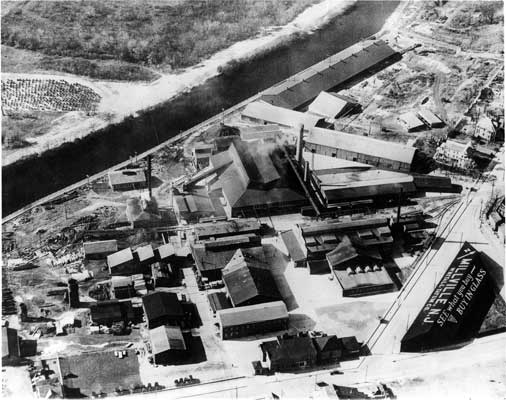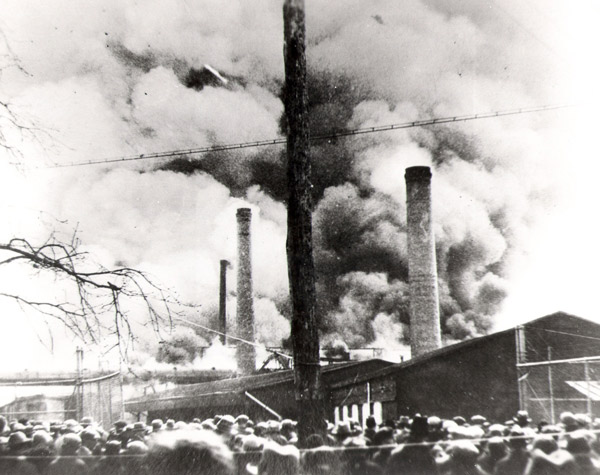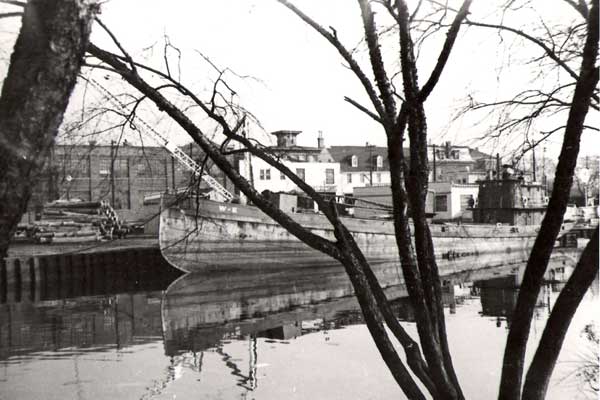Debra A. Barsotti
Research Journalist
Citizens United to Protect the Maurice River
and Its Tributaries, Inc.
The Maurice River Reaches Project
Upper Works (Whitall Tatum Co.)
Reach #3
 Millville's American Legion Post and Millville Public Library are situated on a site of historic significance. "The Legion site now is the upper part of the Whitall Tatum Glass Factory," explained Everett Turner. The upper factory was in the Third Ward. See 1876 Atlas of Cumberland Co.
Millville's American Legion Post and Millville Public Library are situated on a site of historic significance. "The Legion site now is the upper part of the Whitall Tatum Glass Factory," explained Everett Turner. The upper factory was in the Third Ward. See 1876 Atlas of Cumberland Co.
Millville Manufacturing Company and "Glasstown" were part of the Third Ward. In the mid-1800's, the Wood family built dwellings for the community of workers who made a living in the factories. In 1801, Millville was organized as a township. In 1803, only 20 buildings had been erected. In 1806, James Lee, who established Eagle Glass  Works near Port Elizabeth, began the first glass factory in Millville. In Shirley Bailey's history of Whitall Tatum, she reported that the factory made "window glass…and probably bottles.
Works near Port Elizabeth, began the first glass factory in Millville. In Shirley Bailey's history of Whitall Tatum, she reported that the factory made "window glass…and probably bottles.
Lee eventually sold the successful glass factory. By then Millville had attracted several hundred residents. Glasstown's facilities expanded under a series of different owners. In 1844, the Whitall Brothers became the owners of Glasstown and by 1849, the Glasstown plant became Whitall Brothers & Co. (photos of insulators from the Whitall-Tatum ca.1922-1938 first insulator machine and glass blowers)
In 1854, Whitall Brothers purchased the Schetterville Flint and Glass Plant, which was in the community of Schetterville. This name existed until the village merged with the city of Millville in 1885. This facility became known as the Lower Works, and the Glasstown plant became known as the Upper Works. (see Schetterville Lower Works plan)
An early newspaper clipping from the Washington Whig, dated March 4, 1816, gives interesting details about the activities of this location:
A property called " Herring Hole Landing On Maurice River at Millville" which included a wharf house and 7 acres of land, was advertised for sale by Joseph M'Ilvaine. The property was located between the furnace and the glassworks.
A late 1800's newspaper report sheds some light on the importance of the Maurice River to the manufacturing operations and the on-going need to keep it accessible to the vessels that supplied raw materials and brought products to market.
There is no masthead on this clipping but the date is Millville, October 15, 1887. The reporter gives an account of a visit to a dredger, or mud digger. The dredger was the "Atlantic" of American Dredging Company, Phila. The captain, William Connor, gave a tour of the rig. The 6-man crew had been working since August to dredge the Maurice River, working from Pea Landing to the Schetterville Wharf. The reporter commented on the fine work of the crew, and observed that at high water the river was 175 feet wide and 12 feet deep, dropping to a depth of 6 feet at low water.
The reporter mentions that there is some disappointment because the crew was almost finished their job. "We regret this exceedingly as the work should be completed as far as Wood's wharf and the river should be straightened from Pea landing to the old gravel wharf or near Reeves' Reach*, and made 6 feet at low water and 100 feet wide all the way. It is now about 4 feet deep and only 50 feet wide."
General William F. Smith, the engineer in charge, had put forth a recommendation for the expansion of the project. The reporter encourages local citizens and officials to lobby Congressman George M. Hires for a $25,000 appropriation for this work.
 Shirley Bailey's research indicated that the Upper Works of the Whitall Tatum Glassworks (Glass Town) was located between the Cotton Mill and the Millville Bridge.
Shirley Bailey's research indicated that the Upper Works of the Whitall Tatum Glassworks (Glass Town) was located between the Cotton Mill and the Millville Bridge.
Just north of the Millville Bridge is Reeves' Coal Wharf*, which was later changed to Bailey's Log Wharf (Where logs unloaded for Bailey's Basket Factory.) (see photo of log boats for basket factory)
http://www.jerseypackage.info/
The structures of Whitall Tatum's Upper Works were torn down in the 1930's. 6/06
 click to navigate the map "up".
click to navigate the map "up". click to navigate the map "down".
click to navigate the map "down". click to navigate the map "left".
click to navigate the map "left". click to navigate the map "right".
click to navigate the map "right". click to "zoom in" for a closer look.
click to "zoom in" for a closer look. click to "zoom out" to back away from the map.
click to "zoom out" to back away from the map. click to get back to the "default" map setting.
click to get back to the "default" map setting. click to learn more about that reach.
click to learn more about that reach.

